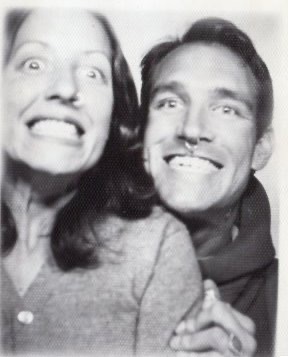
In San Francisco in the early 90’s it seemed like everyone from lawyers to street punks was getting pierced and tattooed. "Body Modification" was the buzzword with tattoo and piercing shops as ubiquitous as Starbucks. Above a popular sex club sat a large school to train would be piercers.
In San Francisco in the early 90’s it seemed like everyone from lawyers to street punks was getting pierced and tattooed. “Body Modification” was the buzzword with tattoo and piercing shops as ubiquitous as Starbucks. Above a popular sex club sat a large school to train would be piercers. Among a certain set of the perpetually underemployed counterculture crowd becoming a certified piercer or tattoo artist was a viable career option right up there with earning a massage certificate or training as a yoga instructor. In no time a level of elitism entered the picture, “who did your work” mattered as well as what you had done. A hierarchy of sorts developed relating to the “edginess” of piercings. The most extreme were the large ear plugs, ever larger septum piercings, back of the neck piercings and any facial piercing that appeared painful (foreheads, Adams apples, bridge of the nose, back of the neck). On the safer side was small dainty eyebrow piercings, small discreet nostril piercings, and upper ear piercings. Another subset was the genital and body piercing which were easier to hide at work.
I had an enormous bull looking nose piercing, commonly called a septum, which was done at the school by Fakir Musafar, the godfather of modern primitivism. It was my only piercing aside from my earring which I got at age 16 at a suburban shopping mall and was subsequently kicked out if the house for. I did have a plethora of tattoos but nothing that I would regret later (like all those folks with large face ink jobs). I was always surprised by the number of “normal clean-cut guys” who had discreet eyebrow piercings. It was popular as was getting a tattoo. Tattoo parlors popped up on every corner to meet the demand. The tattoo designs ranged from the resurgence of old school flash tattoos (Sailor Jerry, Ed Hardy), discreet asian inspired lotus flowers/ Chinese lettering to the massive “modern primitive” tattoos. The latter were especially popular with the gym bunny gays, appearing on the more meaty parts of the body- the chest, legs, biceps and back. Big and all black with the natural skin color acting as the negative space. They often were vaguely tribal/ maori looking, and in the end became extremely generic and sought after. They really meant nothing as they had no distinct elements to them, just swirls and spirals or maybe a vague fish or winged bird. Large, bold but pretty non committal, kinda like the 90’s themselves. And man do they look dated now.
The modern primitive trend eventually went mainstream with tattoos becoming normalized along with modest facial piercings. A tattoo is no longer an obstacle at most job interviews. The trends in piercing and tattoos continues and since prehistory are still used to mark what subculture one identifies within society. For a brief moment in time though in the early 90’s it was a “thing” that caught on like fire and served as an entry point for people to explore alternative ways of existing in the world. For that I’m grateful.



Ah San Francisco – I got fond memories of that city so yeah I guess I did leave part of my heart in San Francisco.
This story really brought me back to the Bay Area of the 90’s when I lived there–you captured it well. I still see lots of poorly-thought-out (IMHO) tattoos around, but the frenzy seems to have abated. It was indeed a way to break out of the usual and express oneself in ways that have since become more accepted–and as you say, for that we can be grateful.
PS–Love the pictures!!!!!
Welcome to Retrospect Warner!
And thanx for your recap of the San Francisco tattoo and body piercing scene.
Here’s to a world where alternate ways of existing are embraced.
A great survey of the many places, utensils, and angles that piercing can generate, and the infinite body points that people request to be tattoo targeted.
Also loved the term “body modification.” Leave it to San Franciscans to come up with a pretentious euphemism. I speak with such arrogance only because San Francisco and its larger environs is my second home town (born and raised in Boston) and the temple of my cultural and political upbringing.. I’m pierced up and down my left ear, but haven’t found a tattoo image that wouldn’t threaten to bore me to tears. Loved your closing words.
I walked gingerly through the reading of this piece, whilc appreciating very much the “insider’s view.” I have gotten used to seeing tatoos and piercings without reacting, but to be brought into the physical details behind the outer expressions still leaves me feeling squeamish. I do recognize and respect what you are saying about it being an important route at certain times for expression of alternative dreams.
When i assigned my college students in one class to create a poem, piece of theatre, a song, a drawing or painting, or any form of creative expression (and then talk about it), one young woman asked if she could show and talk about her tatoo. I asked if it was on a part of her body that would allow her to comfortably let the whole class look at it; she said yes. I then said I would accept her approach to the assignment and specifically said I wanted her to use the tatoo she already had–definitely not get a new one for the purpose of the class assignment (even though everyone else was creating something new for the assignment). She gave a very meaningful presentation about her tatoo and I was proud of myself for incorporating that form of creative art.